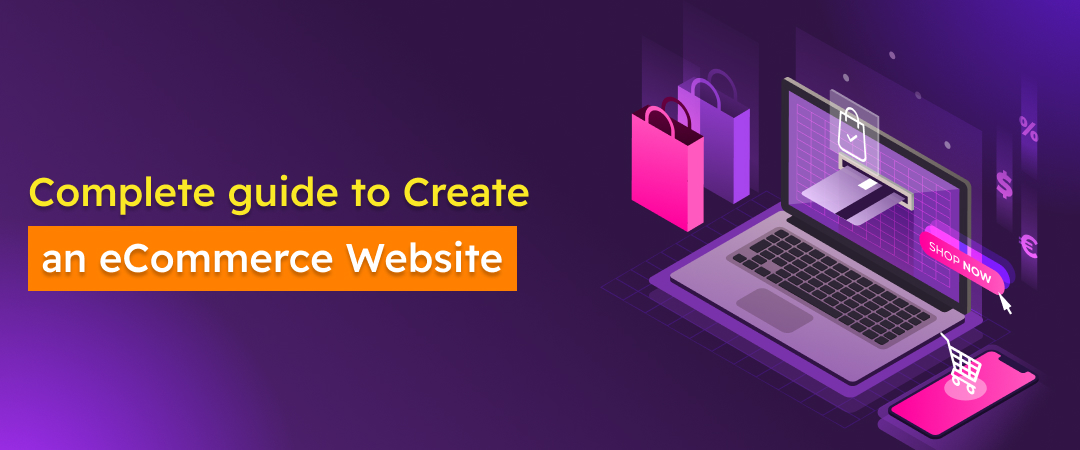
Creating an e-commerce website can be a game-changer for your business, opening up opportunities to reach customers worldwide. However, building a successful e-commerce site involves more than just setting up a web page and listing products. It requires careful planning, strategic design, and effective marketing. In this guide, we’ll walk you through the essential steps and tips to create an e-commerce website that not only looks great but also drives sales.
Table of Contents
1. Choose the Right E-Commerce Platform
The first step in creating an e-commerce website is choosing the right platform. The platform you select will impact every aspect of your online store, from design flexibility to payment processing.
Popular E-Commerce Platforms:
- Shopify: Known for its ease of use and powerful features, Shopify is a great choice for beginners and established businesses alike. It offers a range of customizable templates and an extensive app store for added functionality.
- WooCommerce: If you’re familiar with WordPress, WooCommerce is an excellent option. It’s a free plugin that turns your WordPress site into a fully functional e-commerce store.
- Magento: A more advanced platform, Magento is ideal for large businesses with specific needs. It offers a high level of customization but requires more technical knowledge.
- BigCommerce: This platform provides robust features and scalability, making it suitable for businesses of all sizes. BigCommerce integrates well with various marketplaces and social media platforms.
Tips:
- Consider your business size, budget, and technical expertise when choosing a platform.
- Look for a platform that offers good customer support, as you may need help during setup and ongoing management.
2. Secure a Domain Name and Hosting
Your domain name is your online address, and it should be easy to remember, relevant to your business, and reflective of your brand.
Choosing a Domain Name:
- Keep it short and simple.
- Avoid numbers and hyphens, as they can cause confusion.
- Use keywords related to your business if possible.
- Ensure the domain name is easy to spell and pronounce.
Selecting a Hosting Provider:
- Shared Hosting: Affordable but less powerful, shared hosting is suitable for small stores with low traffic.
- VPS Hosting: A step up from shared hosting, VPS hosting offers more resources and better performance.
- Dedicated Hosting: Ideal for large e-commerce stores with high traffic, dedicated hosting provides the most resources but at a higher cost.
Tips:
- Choose a hosting provider with excellent uptime, as downtime can lead to lost sales.
- Ensure the hosting service offers SSL certificates, which are essential for securing your site and protecting customer data.
3. Design Your Website with User Experience in Mind
The design of your e-commerce website plays a crucial role in how customers perceive your brand and whether they decide to make a purchase.
Essential Design Elements:
- Responsive Design: Your site must be mobile-friendly, as a significant portion of online shopping is done on smartphones and tablets.
- Simple Navigation: Make it easy for users to find what they’re looking for with clear menus and search functionality.
- High-Quality Images: Use professional images that showcase your products from multiple angles. High-quality visuals can significantly impact purchasing decisions.
- Clear Call to Action (CTA): Guide your customers towards making a purchase with clear and compelling CTAs like “Buy Now,” “Add to Cart,” or “Checkout.”
Tips:
- Use a consistent color scheme and typography that aligns with your brand identity.
- Include customer testimonials, reviews, and trust badges to build credibility.
4. Add Products and Optimize Listings
Once your site design is ready, it’s time to add your products. Each product listing should be optimized to attract both search engines and potential customers.
Product Listing Best Practices:
- Compelling Product Titles: Include key information such as brand, model, color, and size. For example, “Men’s Nike Air Max 270 Sneakers – Black/White.”
- Detailed Descriptions: Provide clear and detailed product descriptions that highlight the benefits and features. Use bullet points for easy readability.
- SEO-Friendly Content: Incorporate relevant keywords naturally into your product titles and descriptions to improve search engine visibility.
- Pricing Information: Clearly display pricing, including discounts, taxes, and shipping costs. Use psychological pricing strategies, like $19.99 instead of $20.00, to encourage purchases.
- Product Variations: If your products come in different sizes, colors, or models, include options for customers to select these variations.
- Customer Reviews: Enable customer reviews on your product pages to build trust and provide social proof.
Tips:
- Regularly update your product listings with new information, images, and customer feedback.
- Optimize images with alt tags that include relevant keywords to improve SEO.
5. Set Up Payment Gateways and Shipping Options
To successfully process orders, you need to set up payment gateways that are secure and convenient for your customers. Additionally, offering various shipping options can enhance the shopping experience.
Choosing Payment Gateways:
- PayPal: Widely recognized and trusted, PayPal is an easy option for both buyers and sellers.
- Stripe: Known for its developer-friendly API, Stripe supports a wide range of payment methods and currencies.
- Square: A popular choice for small businesses, Square offers both online and in-person payment processing.
- Authorize.Net: A reliable payment gateway that supports various payment methods, including credit cards and eChecks.
Shipping Options:
- Flat-Rate Shipping: Charge a fixed shipping fee regardless of order size or destination.
- Free Shipping: Offer free shipping to increase conversion rates, possibly with a minimum order amount.
- Real-Time Shipping Rates: Calculate shipping costs based on the customer’s location and the weight of the products.
Tips:
- Display all available payment methods and shipping options clearly at checkout.
- Consider offering local pickup or same-day delivery if applicable.
6. Implement Essential E-Commerce Features
To create a successful e-commerce website, you’ll need to implement various features that enhance user experience, improve security, and streamline operations.
Must-Have Features:
- Shopping Cart and Checkout: Ensure your shopping cart is easy to use and the checkout process is streamlined. Reduce the number of steps required to complete a purchase to minimize cart abandonment.
- User Accounts and Guest Checkout: Allow customers to create accounts for faster checkouts in the future but also offer a guest checkout option for those who prefer not to register.
- Wishlist Functionality: Let customers save items to a wishlist for future purchases. This feature can also help you gather insights into popular products.
- Inventory Management: Use inventory management tools to track stock levels, set up low-stock alerts, and automatically update product availability on your site.
- Customer Support: Offer multiple channels for customer support, such as live chat, email, and phone support. A comprehensive FAQ section can also help address common questions.
Tips:
- Regularly test your checkout process to ensure it’s working smoothly across all devices.
- Use analytics tools to track customer behavior and identify potential areas for improvement.
7. Focus on SEO and Marketing
To attract customers to your e-commerce website, you need to invest in SEO and marketing strategies. These efforts will help you rank higher in search engine results and drive targeted traffic to your site.
SEO Best Practices:
- Keyword Research: Use tools like Google Keyword Planner or SEMrush to find relevant keywords for your industry. Incorporate these keywords into your product titles, descriptions, and meta tags.
- On-Page SEO: Optimize your site’s structure, including URL hierarchy, internal linking, and meta tags. Use descriptive URLs and add alt text to images.
- Content Marketing: Create high-quality content, such as blog posts, videos, and infographics, to attract visitors and establish your authority in your niche.
- Backlinks: Build high-quality backlinks from reputable websites to improve your domain authority and search engine rankings.
Marketing Strategies:
- Social Media Marketing: Promote your products on social media platforms like Instagram, Facebook, and Pinterest. Engage with your audience through posts, stories, and ads.
- Email Marketing: Build an email list and send regular newsletters with product updates, discounts, and personalized recommendations.
- Influencer Marketing: Collaborate with influencers in your niche to reach a larger audience and build credibility.
- Paid Advertising: Use pay-per-click (PPC) ads on Google and social media platforms to drive targeted traffic to your site.
Tips:
- Monitor your SEO efforts with tools like Google Analytics and Google Search Console to track performance and make data-driven decisions.
- Regularly update your content and marketing strategies to keep up with industry trends and customer preferences.
8. Ensure Website Security and Compliance
Security is crucial for any e-commerce website, as you’ll be handling sensitive customer information, including payment details. Additionally, your site must comply with legal regulations to protect both your business and customers.
Security Measures:
- SSL Certificates: Ensure your site has an SSL certificate to encrypt data and protect customer information during transactions.
- Payment Security: Use secure payment gateways that comply with the Payment Card Industry Data Security Standard (PCI DSS).
- Data Protection: Implement strong password policies, regular security updates, and backup protocols to protect against data breaches.
- Privacy Policy: Create a comprehensive privacy policy that outlines how you collect, store, and use customer data.
Compliance Considerations:
- GDPR Compliance: If you operate in or sell to customers in the European Union, ensure your site complies with the General Data Protection Regulation (GDPR).
- Terms and Conditions: Clearly outline your terms and conditions, including return policies, shipping times, and payment terms.
- Tax Compliance: Understand and implement tax collection for the regions where


